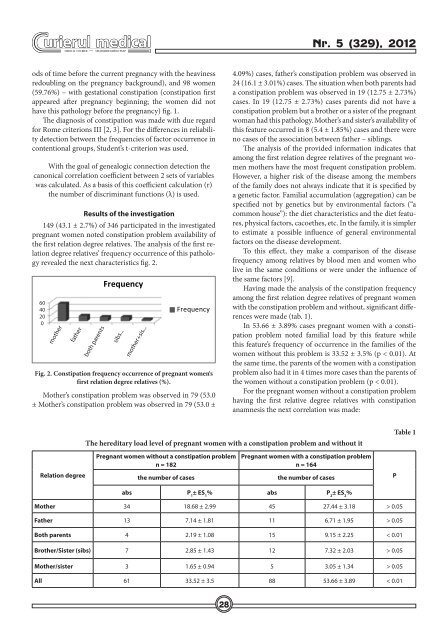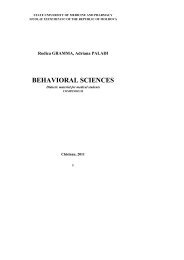Curierul medical, Nr. 5 - Universitatea de Medicină şi Farmacie
Curierul medical, Nr. 5 - Universitatea de Medicină şi Farmacie
Curierul medical, Nr. 5 - Universitatea de Medicină şi Farmacie
Create successful ePaper yourself
Turn your PDF publications into a flip-book with our unique Google optimized e-Paper software.
ods of time before the current pregnancy with the heaviness<br />
redoubling on the pregnancy background), and 98 women<br />
(59.76%) – with gestational constipation (constipation first<br />
appeared after pregnancy beginning; the women did not<br />
have this pathology before the pregnancy) fig. 1.<br />
The diagnosis of constipation was ma<strong>de</strong> with due regard<br />
for Rome criterions III [2, 3]. For the differences in reliability<br />
<strong>de</strong>tection between the frequencies of factor occurrence in<br />
contentional groups, Stu<strong>de</strong>nt’s t-criterion was used.<br />
With the goal of genealogic connection <strong>de</strong>tection the<br />
canonical correlation coefficient between 2 sets of variables<br />
was calculated. As a basis of this coefficient calculation (r)<br />
the number of discriminant functions (λ) is used.<br />
Results of the investigation<br />
149 (43.1 ± 2.7%) of 346 participated in the investigated<br />
pregnant women noted constipation problem availability of<br />
the first relation <strong>de</strong>gree relatives. The analysis of the first relation<br />
<strong>de</strong>gree relatives’ frequency occurrence of this patholo-<br />
Frequency<br />
gy revealed the next characteristics fig. 2.<br />
60<br />
40<br />
20<br />
0<br />
60<br />
40<br />
20<br />
0<br />
mother<br />
father<br />
both parents<br />
Frequency<br />
sibs...<br />
mother+sis...<br />
Frequency<br />
Frequency<br />
Fig. 2. Constipation frequency occurrence of pregnant women‘s<br />
first relation <strong>de</strong>gree relatives (%).<br />
Mother’s constipation problem was observed in 79 (53.0<br />
± Mother’s constipation problem was observed in 79 (53.0 ±<br />
Relation <strong>de</strong>gree<br />
28<br />
<strong>Nr</strong>. 5 (329), 2012<br />
4.09%) cases, father’s constipation problem was observed in<br />
24 (16.1 ± 3.01%) cases. The situation when both parents had<br />
a constipation problem was observed in 19 (12.75 ± 2.73%)<br />
cases. In 19 (12.75 ± 2.73%) cases parents did not have a<br />
constipation problem but a brother or a sister of the pregnant<br />
woman had this pathology. Mother’s and sister’s availability of<br />
this feature occurred in 8 (5.4 ± 1.85%) cases and there were<br />
no cases of the association between father – siblings.<br />
The analysis of the provi<strong>de</strong>d information indicates that<br />
among the first relation <strong>de</strong>gree relatives of the pregnant women<br />
mothers have the most frequent constipation problem.<br />
However, a higher risk of the disease among the members<br />
of the family does not always indicate that it is specified by<br />
a genetic factor. Familial accumulation (aggregation) can be<br />
specified not by genetics but by environmental factors (“a<br />
common house”): the diet characteristics and the diet features,<br />
physical factors, cacoethes, etc. In the family, it is simpler<br />
to estimate a possible influence of general environmental<br />
factors on the disease <strong>de</strong>velopment.<br />
To this effect, they make a comparison of the disease<br />
frequency among relatives by blood men and women who<br />
live in the same conditions or were un<strong>de</strong>r the influence of<br />
the same factors [9].<br />
Having ma<strong>de</strong> the analysis of the constipation frequency<br />
among the first relation <strong>de</strong>gree relatives of pregnant women<br />
with the constipation problem and without, significant differences<br />
were ma<strong>de</strong> (tab. 1).<br />
In 53.66 ± 3.89% cases pregnant women with a constipation<br />
problem noted familial load by this feature while<br />
this feature’s frequency of occurrence in the families of the<br />
women without this problem is 33.52 ± 3.5% (p < 0.01). At<br />
the same time, the parents of the women with a constipation<br />
problem also had it in 4 times more cases than the parents of<br />
the women without a constipation problem (p < 0.01).<br />
For the pregnant women without a constipation problem<br />
having the first relative <strong>de</strong>gree relatives with constipation<br />
anamnesis the next correlation was ma<strong>de</strong>:<br />
The hereditary load level of pregnant women with a constipation problem and without it<br />
Pregnant women without a constipation problem<br />
n = 182<br />
Pregnant women with a constipation problem<br />
n = 164<br />
the number of cases the number of cases<br />
abs P 1 ± ES 1 % abs P 2 ± ES 2 %<br />
Mother 34 18.68 ± 2.99 45 27.44 ± 3.18 > 0.05<br />
Father 13 7.14 ± 1.81 11 6.71 ± 1.95 > 0.05<br />
Both parents 4 2.19 ± 1.08 15 9.15 ± 2.25 < 0.01<br />
Brother/Sister (sibs) 7 2.85 ± 1.43 12 7.32 ± 2.03 > 0.05<br />
Mother/sister 3 1.65 ± 0.94 5 3.05 ± 1.34 > 0.05<br />
All 61 33.52 ± 3.5 88 53.66 ± 3.89 < 0.01<br />
Table 1<br />
P

















